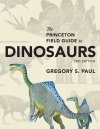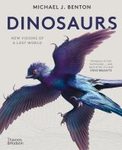By
Leon (NHBS Catalogue Editor)
18 Apr 2025
Written for Hardback
grv

If you have ever seen a diagram of a dinosaur skeleton in a book or scientific paper—white bones, black silhouette, I am looking at you—odds are that it was drawn by independent palaeontologist and palaeoartist Gregory S. Paul, or at the very least inspired by his work. As a consultant and illustrator-for-hire, he has been researching and drawing these diagrams for over 40 years, and
The Princeton Field Guide to Dinosaurs brings together the largest such collection in print. I have previously reviewed his companion volumes on pterosaurs and extinct marine reptiles, which is coming at it somewhat the wrong way around. His tenure with Princeton University Press started back in 2010 with the first edition of this dinosaur guide, followed by the second edition in 2016, and the third edition in May 2024. High time, thus, to make up for that lack of review coverage. In the process, I will address the question of whether buyers of the second edition should upgrade.
If the idea of a field guide to extinct creatures sounds contradictory, think of them as illustrated guides for the palaeo-enthusiast. Paul has chosen a template and stuck with it: this third edition, like the previous ones and his other books, follows the same format, with many sections almost identically worded. As before, the book breaks down into an introduction to dinosaur biology (82 pages) and the species accounts (288 pages).
The introduction will set you up with everything you need to know, covering the history of research, a description of the Mesozoic world and its inhabitants, the era's mass extinctions, a series of palaeogeographical maps, the steps involved in becoming a fossil, and the reverse steps to successfully excavate these. As before, Paul entertains some speculative zoology, imagining a spot of time travel for a dinosaur safari, and asking what might have happened had the asteroid missed and how we might interact with dinosaurs today. Most of the introduction is an extended primer on all aspects of dinosaur biology, including anatomy, appearance, locomotion, physiology, sensory biology, behaviour, reproduction, and the evolution and loss of flight.
One thing to note is that Paul does not provide citations to back up claims and includes only the briefest of recommended reading sections; this book aims to be neither textbook nor encyclopedia. Readers will want to keep in mind, as alluded to in previous reviews, that Paul has opinions and is not afraid to use them. Now, I think there is little here that will set you on the wrong foot; it is just that context as to how widely accepted his views are is not always present.
The field guide section arranges taxa phylogenetically, though given that this is forever in flux, he has again "used a degree of personal choice and judgment to arrange the groups and species within the groups" (p. 76). Some 1700 species names are in circulation, but a substantial number of these are invalid, duplicated, or based on inadequate remains, so Paul limits himself to some 800 generally accepted ones that have sufficient fossil material behind them. Species are again described in telegram-style entries, listing size and weight estimates, known fossil remains, anatomy, geological age, location and geological formation of fossils, habitat, lifestyle, and other notes. This is the reference section of the book, collecting facts without a guiding narrative. Where sufficient material is available, he provides his signature drawings of skulls or (partial) skeletons, as well as the occasional life reconstruction. The few palaeoart pieces are, to my taste, still a mixed bag, though I liked some of these much better. There are no photos of fossils.
Having spent the last 13 days spelling out this book, it is clear that a huge amount of work has gone into compiling all this information. Imbibing it all for days on end brings about a Gestalt shift in your perception of dinosaurs. Any lingering notion of these as mythical monsters is swept away, replaced by a blossoming of biodiversity over millions of years, with evolution producing many and sometimes wild variations on themes. Some other impressions I came away with are just how many species are based on fragmentary fossils. Especially the skeletal diagrams, which make a point of showing only the bones we have, drive this point home. Very few illustrations are marked as composites. Simultaneously, it is a testament to the hard work of generations of researchers that we have learned so much from such challenging material.
Given that I own the second edition, I compared the two in some detail for this review. The one-liner is that the third edition is not a drastically different book but is more of the same. Lest that sound negative: more is good. Increasing from 360 to 384 pages, the third edition has been expanded and revised throughout, the changes many and subtle. This, of course, sounds like the generic claim every publisher makes about new editions, but rather than regurgitating my changelog, which would be as riveting as reading the phone book, let me elaborate. The first part, in replicating the previous edition word for word, quickly reveals where Paul has inserted additional paragraphs or rewritten sections to add the latest findings and opinions. In the field guide section, I noticed updates to size, mass, and age estimates throughout. Paul has introduced new divisions and has added well over 50 new species. Some species have been removed, others subsumed, and some groups have been thoroughly reshuffled. There are new illustrations, expanded ones, and subtly changed ones, adding extra bones.
Given that many readers might already possess an older version, should you upgrade? It all depends on your mileage with them. For casual readers, this is going to be a personal choice dictated by, e.g. shelf space and liquidity. Unless you are a completist who must have every good dinosaur book, maybe you want to hold on to your money and check out the (*drumroll*) three-volume dinosaur encyclopedia that Princeton announced for later this year. If, however, the above changes sound meaningful and relevant to you, then you are in the market for the third edition. For palaeontologists or palaeoartists who regularly consult their current copy, the choice is straightforward: you need to upgrade. If you happen to be new to these books and are looking for a detailed reference work to as many dinosaurs as possible, or need scientifically sound illustrations, look no further. Paul's drawings are a benchmark in the discipline, and this guide is a mouth-watering cornucopia of detailed skeletal diagrams.




























































